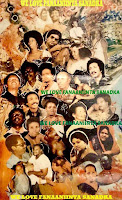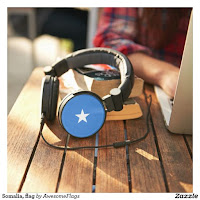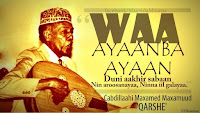Facts and Fables Compiled
The compilation Sweet As Broken Dates: Lost Somali Tapes from the Horn of Africa has been captivating the attention of the international press. As all interested could notice, it’s highly praised and rightfully so. What eludes the uninformed eye and inexperienced soul is that the coverage also propagates known and new mythes about Somalia and its Music. I’ll handle a few of the dazzling acrobatics presented as natural facts by the giants of the media, in some cases (unintentionally) generously fed by the title of the album and the promotional buzz. How influential these media outlets are is illustrated by the huge number of sources that literally copied and pasted (parts of) their reviews.
Music History
 On Saturday 26 August, I replied to a BBC tweet to signal that the interesting article it's pushing was marred by a few misleading, misinforming and potentially history-bending factual inaccuracies, as well as other less harmful flaws and I briefly mentioned several. The reporter followed and messaged me within minutes: “I will make those changes on Monday”, “Could you please take that tweet down as it is public”. I messaged her back: “Done! It's just a correction, not a criticism. It's a great write up”.
On Saturday 26 August, I replied to a BBC tweet to signal that the interesting article it's pushing was marred by a few misleading, misinforming and potentially history-bending factual inaccuracies, as well as other less harmful flaws and I briefly mentioned several. The reporter followed and messaged me within minutes: “I will make those changes on Monday”, “Could you please take that tweet down as it is public”. I messaged her back: “Done! It's just a correction, not a criticism. It's a great write up”. The promised changes didn't happen (yet)! What well happened is nothing short of an absolutely hilarious gaslighting and unnecessarily stubborn ipsedixitism, persistently averring without a shadow of elaboration that there was nothing to change! Inadvertently letting mistakes slip into an important work befalls us all incidentally; categorically refusing to change an iota, despite an overwhelming evidence and historical necessity, reeks of intellectual dishonesty.
The promised changes didn't happen (yet)! What well happened is nothing short of an absolutely hilarious gaslighting and unnecessarily stubborn ipsedixitism, persistently averring without a shadow of elaboration that there was nothing to change! Inadvertently letting mistakes slip into an important work befalls us all incidentally; categorically refusing to change an iota, despite an overwhelming evidence and historical necessity, reeks of intellectual dishonesty.Following a series of evasive and unsubstantiated arguments, not to speak of outright fabrications, the journalist concocted a miraculous blanket panacea: My very first block ever in my 20+-year-experience online! Strange because she messaged me twice as many times as I messaged her back. Who needs whom? Futile and even counterproductive as there are other channels to communicate my observations. Since the BBC does not allow commenting on the site, the best viable option was to submit my reflections through their online framework. I did that ten days ago and the BBC has yet to react.
Where exactly does the shoe wring?
1. Dhaanto
Dhaanto: The Somali reggae
During the 1980s, "dhaanto", an ancient Somali folk song and dance was revived. Historically, it was played without instruments, with hand-clapping and foot-stamping used as rhythmic accompaniment.
Contrary to the emphatic assertions above, dhaanto was first:Nomadic tribes would take their camels into their ranch at night and venture out to compete with each other. This folk style was enhanced with instruments by the likes of Shareero band and Khadija Qalanjo, the first artist to begin the modernisation of dhaanto.
a) Revived by the Daraawiish (dervishes) in the 1900s;
b) Modernised in the 1930s by touring theatre troupes with singers, dancers and traditional acoustic instrumentalists, such as Xaaji Baal Baal/ Haji Bal Bal. That's even considered as a watershed development as it's one of the starting points of modern Somali music;
c) Electrified in the 1970s by Horseed, Waaberi, Halgan, Madaalayaasha, Bakaaka... and in the 1980s by Heegan, iftin, Shareero, Onkod, Danan, Sawtul Raxma… There are even as yet unverifiable claims affirming that Horseed, which at the time went by the name Ex-Bana Estro, had dhaanto hits in the 1950s and 60s.
 It's a delightful double blessing that some of Shareero's dhaanto videos survived the civil war and are widely circulated, while many footages and records by other bands unfortunately (probably) perished. However, it doesn't justify rewriting the history of Somali music.
It's a delightful double blessing that some of Shareero's dhaanto videos survived the civil war and are widely circulated, while many footages and records by other bands unfortunately (probably) perished. However, it doesn't justify rewriting the history of Somali music.The author of the feature seems partial to Shareero, a group that doesn't need harmful promotion as it's already great in its own right.
One of Shareero's dhaanto tracks performed by children from Somalia, Norway and other countries
The original
In addition to crediting Shareero with the modernisation of dhaanto, the photo on Iftin’s song doesn't depict Iftin but Axmed Naaji and Maxamuud Cabdalla Xuseen “Jeeri” in their Shareero period. Besides, on basis of out-of-the-blue reasoning that "the rights are held by shareero so that's as accurate as it gets"(!!!), the reporter attributes the track Qays & Layla to Shareero with pictures and all!
According to the compilation, the song was recorded in 1977 by “Sharero Band feat. Faadumo Qaasim”. In fact, Faadumo is not only the lead singer, she's also the copyright owner, as the liner notes clearly state. Can the label clarify how come she’s only featuring in her own work? Wouldn't the other way around be more logical? Like this:
It’s, moreover, common knowledge among Somali music fans and connoisseurs that Shareero didn’t have a horn section and the wind instruments are dominant on Qays & Layla and the album it belongs to. I posted the whole tape, which was stamped with “Faadumo Qaasim, Faynuustii Fanka - 1974” (“FQ, The Lantern of Art/Music”), and I always thought the backing musicians were from Waaberi as the tunes sound perfectly like Waaberi. Anyway, it could also be one of the (hybrid) session outfits FQ and other artists occasionally employed, and that's probably why only FQ was mentioned on the cassette. Bottom line: It's striking the BBC journalist decided to eliminate Faadumo Qaasim from the whole equation!
This is btw the 1977 FQ & Shareero version:
2. Khadra Daahir is (creatively) misquoted and misinterpreted:
"They used to call us all kinds of nicknames before the 1970s. Some women used to hide," 70s star singer Khadra Daahir told the BBC.
"People said we were dead, lost and a disgrace to our people," she recalls.
The song starts at 2:00
KD is talking about the generation of artists before hers, i.e. those from the 1960s and earlier, and she says: They (female artists) used to adopt/were given pseudonyms, some used to hide [their identity]. A woman or a person [female or male] working in the arts was considered dead. "Lost and a disgrace to our people" are not in the embedded video. The journo said there’s a longer version but didn’t react to my suggestion to embed it or my request for a link.
The Somali society was and, alas, still is biased towards women and KD makes that unequivocally clear. This is an issue all Somalis, women and men, have to address and endeavor tirelessly to change. Putting (inadvertently) words that are not corroborated by the embedded footage in KD's mouth - or anybody else's - contributes nothing but confusion and misinformation.
3. Record companies
During this period, record companies could not release music to the market
They could and did (see below).
Music Industry
Music Industry
Barre’s regime effectively nationalized the music scene, with bands and production controlled by ministries and the national radio. A great deal of Somali music was rarely disseminated, confined to broadcast on state run radios and the live performances in dance halls, theaters, and ball rooms of Mogadishu’s hotels. -- liner notesMirroring the liner notes of the compilation, a constellation of news titans such as AFP, Yahoo, Al Jazeera, BBC, Wall Street Journal etc. inform dutifully that music companies didn't exist in Somalia during the dictatorship (1969-1991)! Le Point, a major weekly in France, takes the cake. It basically copies and pastes errors in AFP's article! As if that were not grave and unprofessional enough, it creates its own urban legends about Somali music!
Le pays ne possédait aucune maison de disques et aucun album n'a donc été produit à l'époque. Son industrie musicale était entièrement dirigée par l'État et le seul canal de diffusion des chansons était la radio ("The country did not have a single record label and thus not a single album was produced at the time. The music industry was entirely run by the state and the radio was the only channel for broadcasting the songs").
 |
| @ Analog Africa |
By mid-1970s the whole music industry was owned by the government and that lasted for about a decade. In the mid-1980s, licences were again granted to a number of companies, popularly known as Studios or Phones. These music shops were pretty much copies of their predecessors from the 70s. However, selling and producing music- and film-related items, mainly k7s and videos, was their main activity. The private music companies produced, in the 70s and 80s, dozens of records and sold hundreds of thousands of k7s.
 |
| Xamar Weyne Market |
It's also noteworthy that a huge number of tapes were recorded at concerts and other live gigs by the audience. Those home-made tapes were widely and wildly exchanged. Although often of lamentable quality, the most recordings that are still alive and kicking belong to this category and the history/emotions they represent is next to none.
Dur Dur were one of the rare few [private bands] -- liner notes
There were countless privately owned bands, mainly playing traditional/rustic music on ancient instruments. Those bands were financially unable to produce their material professionally. Nevertheless, some of them recorded with a simple boombox and sold the tapes at the markets and party circuits which constituted their main income source.
The musicians and dancers belong to the same traditional band
The Asian Factor
One of the recurrent opinions-elevated-to-holy-facts almost all the critiques advance is that Somali music is heavily influenced by a plethora of regions. Remarkable in the analysis is that Africa is rarely mentioned, despite the indubitable, research-vouched N-E-W-S-African mosaic patterns in Somali artists' creations! In contrast herewith, the impact of South and East Asian nuggets on Somalia's music, and specially Indian and Bollywood radiations are abundantly perceived.

I'm not saying that those effects aren’t there; they possibly are. I just would like to see, preferably but not per se watertight and unassailable evidence,or at least credible and elaborate rationale. Purporting, for example, that Somali music is heavily influenced by Indian raga and Bollywood because the two countries share pentatonic scales and high-pitched female vocalists is a baffling argument that's hard to take seriously. It's like saying that water is bounteously available on Mars because high-res photoshops show meandering streaks and grooves that look like rivers and oceans! Shall we then book a trip to the Red Planet for a hitchhike adventure on high heels? I'll pay the bill if you can pedal the shuttle.
Lost Tapes
I'm absolutely delighted that a strong spotlight is currently shining on Somali music. Unfortunately, I also know that many Somalis - including some I'm personally acquainted with and myself - are not happy with the title of the compilation. Only a distorted and numb mind can picture how much Somalia has lost in the last couple of decades. That's why it feels awkward, acrid and unwise that cassettes/tracks owned and cherished by countless Somalis are being qualified and commercialized as lost! All the more that the tracks on the compil were/are a few clicks or calls away for anybody interested and streetwise in Somali music world. The title also exudes a bitter-sour taste for many since an indefinite number of tapes have effectively been lost.
Throughout Somalia's history, and specially during the oppressive colonial and dictatorial periods, poetry and music were the choicest vehicles for political propaganda. There were, for instance, many plays and albums supporting or protesting against the military regime. Some helped to boost the popularity of the junta. Others contributed to its demise. Even a single song is believed to have toppled a Somali government in 1967... and maybe even two govs...
Following the fall of the central government in 1991, piles of k7s and instruments were destroyed by the rivaling factions of all tribal and ideological colours. They saw in many songs a machine gun pointing at them. Even the common citizens had to get rid of their collections to be on the safe side of the frontline. Nobody wanted to be accused of listening to "enemy tracks", let alone possessing a whole collection of the damned cassettes. Within weeks the sewers and drains, teeming with magnetic polyester, were the only/primary hubs belting out the "hits of the past"! My tapes were (I digitized them and gifted them away) the umpteenth copy of what was saved from that cultural onslaught.
Some radio operators carved a plan to save their collections. Recordings were dispatched to neighboring countries, like Djibouti, and protected from continued bombardment.
“We buried the tapes under the ground so the bomb’s won’t hit,” said an elderly journalist -- liner notesI understand how enticing it is to call the comp "Lost Tapes..." as the tracks are reportedly culled from the sources described above. It's unfortunate, though, the title opened the traumatizing floodgates of the media for self-appointed saviours, rescuers, conquistadors and the likes. I hope Ostinato Records will take this to heart when it releases the next albumS. The sooner the better. Break a leg... or both!
P.S. Tangentially, an anonymous genius has lately been posting on this blog quite edifying comments with the precise regularity of a Swiss watch and in the form of a single phrase: Mogadishu and its music are shitholes! Since the Honourable Gentlekiddo is already well-versed in the the dark side of our moon, I think it’s high time to broaden his horizons and musical vocabulary… free of charge.
Mogadishu 1969
Mogadishu 2017











